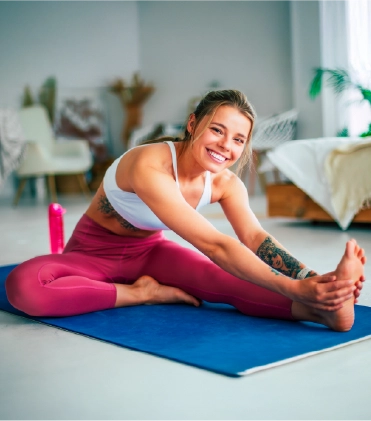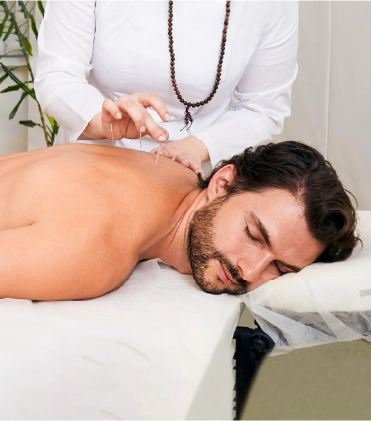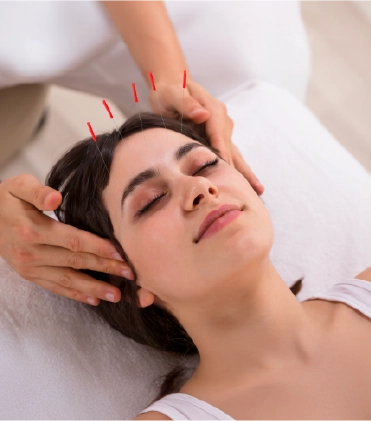What is the treatment?
Yoga is an ancient practice that originated in India over 5,000 years ago as part of the spiritual traditions of Hinduism. These practices were performed to treat the mind, body, and soul through a holistic approach. It involves slow movements, breathing exercises, and meditation to promote physical wellness, mental health, and inner peace. Yoga is a holistic approach that can be performed to balance self-discipline, focus, and growth.
Philosophy/Origin
Yoga is an ancient practice, but it has been modified into various styles. Each type of yoga is performed for its unique benefits according to its philosophical basis. Yoga highlights the principles of peace that come from within and are based on the connection of the body’s different aspects. In Ayurvedic, it is believed that yoga is not just a practice or meditation, but it is a way of living which promotes overall well-being. It provides different physical and mental benefits, which may include strength and flexibility, mental clarity, and awareness.
Physical Benefits
Mental/Emotional Benefits
Long-Term Wellness
Long-term yoga practice supports cognitive function and mental clarity, which helps individuals cope with stress and handle conditions more effectively. Yoga encourages the connection of the body with the mind and also helps individuals make a healthy lifestyle, which improves overall quality of life.
Ideal Audience
Yoga is suitable for people of all ages and fitness levels, from beginners looking for gentle exercise to experienced practitioners who prefer more intense workouts. It can be used according to various needs and goals of each individual which may include physical fitness, stress management, and mental well-being.
Specific Conditions
The treatment of Yoga involves the following steps
Initial Warm-Up
It is important to perform simple warm-up exercises to prepare the body for the yoga session. These may also involve gentle stretching and simple range of motion exercises for each joint.
Guided Breathing (Pranayama)
The Yoga therapist guides the individual to perform breathing exercises, which help increase focus and concentration. Different breathing patterns are used, such as alternate nostril breathing or deep diaphragmatic breaths.
Asanas (Postures)
The yoga session involves various poses which are performed according to the needs of each individual. These poses may range from simple stretches, like Cat-Cow, to more complex ones, such as balancing poses or Tree Pose.
Flow Practice (Vinyasa)
A series of poses are performed in a flow that are linked together and are performed with specific breathing patterns. It is usually performed for more active sessions. It promotes strength, flexibility, and heart health.
Meditation and Mindfulness
After the physical practice, individuals often engage in silent meditation under the guidance of an expert therapist. It is performed to improve inner awareness and to work on mindfulness.
Savasana (Corpse Pose)
The session typically ends with savasana, which involves a relaxation pose in which the body lies still and relaxed. It allows the mind and body to absorb the benefits of the Yoga session.
Closure
The therapist guides the individual to think about the emotions that arose during and after the session and try to understand without judging. It carries a sense of calm and mindfulness into their daily lives.
What to Expect
individuals may experience mild muscle soreness as their bodies adapt to new poses and stretches. Each session is specifically designed to increase balance. The session starts with simple poses and gradually proceeds to more challenging movements. The mind may not be calm at first, but over time, individuals learn to refocus and stay present, which increases their mindfulness and emotional control.
Immediate Effects
Long-Term Effects
Before the Treatment
It is better to avoid tight clothing as it can interfere with movements and range of motion exercises. A yoga mat is advised to provide stability during poses. It is better to avoid heavy meals for at least 1 to 2 hours before the session to prevent discomfort during practice.
Aftercare
It is important to drink plenty of water after the session to promote recovery. Light stretching after the session helps to maintain flexibility overtime and prevent stiffness of joint and muscles. The therapist also suggests practicing daily mindfulness or breathing practice to increase the benefits of the session.
Yoga is highly accessible and offered through various formats, including classes at fitness centers, dedicated yoga studios, and wellness retreats. According to specific preferences and goals, there are different styles, such as Hatha, Vinyasa, Ashtanga, and restorative yoga. Platforms like Wellencia also provide an easy way to practice yoga under the guidance of expert practitioners.









